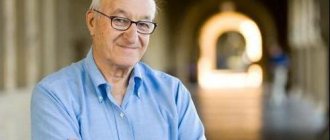Modern theories of personality
If we approach the description and definition of modern personality theories formally, then according to the diagram presented in Figure 25, we can see that there are at least five different reasons for dividing personality theories into groups, and according to each of these reasons, two or three groups of theories can be distinguished personality.
The lines on the diagram connecting different types of personality theories show that personality theories identified according to one characteristic can be grouped (divided) according to another characteristic. For example, psychodynamic theories can be both experimental and non-experimental. The same is true for sociodynamic and interactionist theories of personality. Moreover, each of the personality theories can be classified on different grounds, and a complete description of the theory according to this scheme is obtained by moving along the lines from top to bottom and sequentially evaluating the same theory on various grounds. For example, humanistic theories of personality are non-experimental theories that represent both the structure and dynamics of personality, they relate to both childhood and adulthood, and describe the psychological properties of personality. Let us turn to the classification of personality theories on individual grounds.
The first basis is how a particular theory explains human behavior. In accordance with this, personality theories can be divided into the following groups: psychodynamic, sociodynamic, interactionist and humanistic.
Psychodynamic theories are called personality theories in which a person as an individual is represented and described in terms that characterize his psychology or inner world. These are terms such as needs, motives, personality traits, character, temperament, will, etc. The explanation of human behavior in these theories is given exclusively from the inside, that is, taking into account the psychology (or physiology) of a person. The fact that a person's behavior can also depend on the situation in which he finds himself at the moment is not taken into account in theories of this kind.
The formation and development of a person’s personality is presented in psychodynamic theories as a change in his psyche, and not as his behavior or reactions to external influences, that is, exclusively as the dynamics of the inner world (hence the name of these theories - psychodynamic).
Well-known examples of sociodynamic theories are the psychoanalytic personality theory of 3. Freud and the theory of personality traits of G. Allport and R. Cattell.
Sociodynamic theories are called personality theories that emphasize an external, behavioral approach to a person's personality. If it is necessary to imagine and describe a person as a person, then typical forms of social behavior of a person, his habits, actions, deeds and reactions to various situations are highlighted. Explanations of behavior within the framework of theories of this type are also given with reference to the situation (it is assumed that the situation determines a person’s behavior, and not his internal, psychological world, that is, it is assumed that changes occurring in a given situation cause corresponding reactions in a person and changes in his behavior).
Within the framework of these theories, the question of the emergence and development of a person as an individual is resolved as follows: stable changes that occur in a person’s behavior under the influence of the social environment or certain situations are changes in his personality. An example of a sociodynamic theory of personality is the theory of B. Skinner and A. Bandura, based on the ideas of social behaviorism.
Interactionist (interaction) theories are theories of personality in which, when describing and explaining a person’s behavior, as well as when studying his emergence and development as a person, both the internal, psychological characteristics of a particular person and his externally observable behavior are taken into account. Iterative theories of personality occupy an intermediate position between psychodynamic and sociodynamic theories. An example of such a theory is the theory of social roles developed by E. Berne1.
Psychodynamic and analytical theories of personality
Psychodynamic personality theory is a personality theory developed by Z. Fred, according to which the main source of human personality development is his innate biological factors (instincts, libido).
In accordance with S. Freud’s theories of personality, there are three main conceptual blocks, which are the leading authorities of personality:
- ID (“It”) is the basis of the personality structure, consists of a set of unconscious impulses (aggressive and sexual).
- EGO (“I”) is a set of executive and cognitive functions of the psyche that are conscious of a person and consist of his knowledge about the world around him.
- SUPEREGO (“super-ego”) is a structure that includes various social attitudes, norms and values of the society in which a person lives.
Finished works on a similar topic
Course work Classification of modern theories of personality 470 ₽ Abstract Classification of modern theories of personality 230 ₽ Test work Classification of modern theories of personality 240 ₽
Receive completed work or specialist advice on your educational project Find out the cost
Analytical theory of personality is a theory of personality developed by C. Jung, who believed that the main source of personality development is its innate psychological factors.
According to this theory, each person inherits primary ideas from his parents, which are called “archetypes.” The meaning of human life is to fill “archetypes” with certain content.
The main conceptual blocks (spheres of personality) in accordance with the analytical theory of personality:
- The individual unconscious is a set of personal feelings and thoughts that are emotionally colored by a person’s consciousness.
- The collective unconscious is the totality of all cultural and historical experience accumulated by humanity during its existence.
- Individual conscious is a structure that acts as the basis of conscious activity and self-awareness of the individual.
Humanistic theories of personality
Humanistic theories of personality occupy a special place among theories that are divided into groups depending on the way they describe personality and explain human behavior, and also characterize the process of personal development of a person. They arose later than many other personality theories related to psychodynamic, sociodynamic and interactionist theories, and, moreover, are in opposition to all of these theories.
Almost all theories of personality that appeared before the early 1940s (it was during this time that humanistic theories of personality arose and developed) in one way or another identified the psychology and behavior of humans and animals. This was reflected in the content of the theories as follows: firstly, they often considered biological instincts and needs as the driving forces of human behavior; secondly, they focused on what unites people and animals, rather than dividing them.
This state of affairs did not please the scientists who later wrote humanistic theories of personality. They advocated a complete rejection of the use of animal data as a means of characterizing and explaining human behavior. In their opinion, only people can be persons, and therefore analogies with animals are inappropriate when describing people as persons. When studying human psychology, it is necessary first of all to pay attention to what distinguishes him from animals. These are the goals and meaning of life, values, morals and much more. When explaining human behavior, it is necessary to focus on these characteristics, and not on biological instincts and needs. Finally, when considering the formation and development of a person as an individual, it is necessary to study his psychology from the point of view of the desire for self-improvement. The author of this criticism and at the same time the most famous humanistic theory of personality was the American psychologist A. Maslow.
Theories are divided into experimental and non-experimental, depending on the method of obtaining data about a person’s personality. In experimental personality theories, the main source of data about them, which forms the basis of theoretical generalizations, are facts obtained in a scientific experiment using modern psychological tests and methods of mathematical statistics. An example of such a personality theory is personality trait theory. Non-experimental theories are theories created on the basis of analysis and generalization of observations, reasoning, etc., i.e. theories based not on experimentally obtained data, but on observations and the scientist’s official guesses. An example of such a theory is the humanistic personality theory of A. Maslow.
Depending on their emphasis on structural or dynamic aspects of personality, theories are divided into two groups with corresponding names: structural and dynamic. Structural theories of personality are focused on describing personality, specifying its structure, and dynamic theories are focused mainly on studying the process of formation, development and change of a person as a personality, i.e. its dynamics. A typical structural theory of personality is the ego theory of personality traits, since its authors were primarily concerned with identifying and describing the characteristics that a person possesses as an individual. In turn, psychoanalytic and humanistic theories of personality can be considered as structural-dynamic [1].
Depending on the fourth criterion - the age range covered by the personality theory - all theories can be divided into the following two groups: Theories that relate mainly to childhood, and theories that cover the entire life of a person. Theories of the first type focus on what constitutes a person from birth to 15-16 years, that is, until the end of childhood. Theories of the second type consider personality in the process of its formation and change throughout life.
Basic theories of personality
Personality orientation - what is it in psychology, its types
Personal hypotheses must be studied and developed in order to understand the person himself, the sequence of his reactions to stimuli.
Psychodynamic theory
The beginning of the psychodynamic hypothesis was laid by S. Freud, who stated that a person is devoid of will and is guided by aggressive, sexual and defensive motives. Domestic psychologist V.N. Myasishchev characterized the organizational personal growth of an individual through the totality of his qualities such as temperament, orientation, level of development, integrity, motivation, etc.
Analytical theory
C. Jung made a great contribution to the analytical personality hypothesis, so it is in many ways similar to the psychodynamic one. He called a personality a set of archetypes - innate and acquired. Jung defined personality structure as the individual uniqueness of various elements of conscious and unconscious behavior, supported by a tendency towards introversion or extraversion.
Humanistic personality theory
The humanistic hypothesis, where K. Rogers showed himself, is based on the fact that it is common for a person to have innate tendencies towards self-actualization, which are initially hidden. Rogers also identified a second (tracking) personality mechanism. Together they form an individual’s holistic personal structure of “I”, “ideal I” and “real I”. These elements can be in complete harmony or, on the contrary, severe disharmony.
In psychology, the concept of “I” and its components are important
Cognitive theory
The founder of cognitive theory, J. Kelly, suggested that a person lives with one desire - to know about everything that happened to him and what will happen in the future. Kelly also determined that the social environment is important to a person, since cognitive theory enhances the intellectual influence on other people, which is comparable to scientists involved in hypotheses and forecasting.
Behavioral theory
Behavioral, also known as “scientific” theory, states that a person’s personality is a product of learning, a structure consisting of conditioned reflexes and social skills, which play a leading role here.
The concept of personality is a widely debated issue, although many definitions exist. Psychology attaches importance to differences in human behavior; they are expressed through temperament, behavior, and specific interests.
Personality structure according to Freud
In Freud's theory of personality, personality structure is depicted as consisting of three areas: the unconscious (Id), the ego, the conscious or self-conscious person (Ego), and the “superconscious” or superconscious person (Super-Ego) [2] (Fig. 26).
According to Freud, the unconscious consists of two basic human instincts: the life instinct and the death instinct. The first encourages a person to preserve and continue life, the second - to put an end to it (destruction)[3]. These two instincts are not realized and not recognized by a person as truly determining his behavior, but they exist and act, nevertheless, forcing a person to constantly seek ways of his complete satisfaction. In realizing these aspirations, a person acts, according to Freud, on the basis of the “pleasure principle.”
However, when a person lives in a modern society among other people, he does not have the opportunity to openly and fully satisfy these instincts, because the living conditions in society, its moral and other norms limit not only satisfaction, but even the open manifestation of these instincts in behavior . A person is raised from childhood to restrain these instincts and eventually learns to do so by learning the rules and norms of cultural behavior in society. The corresponding norms and associated forms of social behavior are also part of his personality, but occupy only its upper part, the “super-ego”. This personality structure regulates a person's behavior based on a "sense of duty and morality."
According to Freud, there is an insoluble conflict between the unconscious and the superego, which gives rise to many intrapersonal problems and conflicts. To a certain extent, a person manages, if not to solve them, then partially or temporarily, through the development and use of psychological defense mechanisms. These are ways to rationally explain and justify human actions that are motivated by instincts, as well as ways to get rid of the feeling of fear that a person may experience due to the awareness that his behavior violates social norms and behaves immorally. Psychological defense mechanisms are part of the third substructure of personality, the “self,” consciousness, or self-awareness. Listed below are some of the psychological defense mechanisms that Freud names and defines in his theory.
- refusal. When reality seems unpleasant to a person, he turns a blind eye to it, tries not to perceive it, denies the existence of the situation or downplays the threat it poses to himself. A common form of this behavior is refusal, denying that criticism is unfair, claiming that what is being criticized does not actually exist. In some cases, denial can play a positive role, for example, when a person is seriously ill and denies this fact (this is how he finds the strength to fight his illness). However, most often, denial prevents people from living and working normally, because, not recognizing the existing danger and refusing fair criticism, they do not take any action to eliminate the danger or correct their own shortcomings.
- suppression. Unlike denial, which in most cases refers to information coming to a person from the outside, repression involves the ego blocking internal impulses that come from the superego and point the person to something unpleasant within himself. In this case, unpleasant experiences and knowledge about oneself that is unacceptable for the individual are, as it were, suppressed from the sphere of his consciousness and do not affect his actual behavior. Most often, thoughts and desires that contradict the moral norms and values accepted by a person are suppressed.







